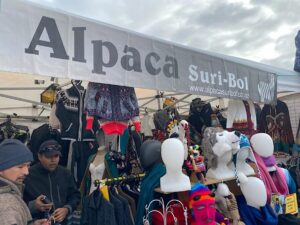Life on the farm
Caitlin Wallace discovers that while no three farms are the same, there are some common experiences shared by all.
Some are young, some old, some are experienced and some are still learning. You will find these kinds of farmers from across the country making their way to the Fieldays. They all seem quite different, but think again. Three farmers from different regions and experience levels are more similar than one would think. These farmers share the common experiences of life on a dairy farm and they all understand what goes into running it. They could all tell you that no matter what the job throws at them, they will tackle it.
Waikato Ways

The paddock is littered with jerseys, happily munching on the grass. Dairy farmer Tracy Rovers points towards the fencing she does on the farm. She then rips up the fresh grass and brings it up to the bulls who are happy to take the offering as opposed to the shy cows who neighbour them.
Nineteen-year-old Rovers grew up on her mum’s farm in the South Waikato town of Tokoroa and loved farming throughout her childhood. Her farming career started at eight years old when she would feed the cows hay before class.  Eleven years later, she works full time. The calving season day starts at 6am when she heads to the farm with over 600 cows to manage. The silage pit is opened and then she lets down the brake for the cows roam free for the day. Rovers continues with the jobs of fencing, grass and pasture management and tractor work. At 3pm she shuts the cows away again for the night. “This is my life,†she says smiling as she looks over the farm.
Waikato’s big farming industry excites Rovers. “We’re a big huge farming community, so there are lots of farming out there, lots of different farms and lots of different cows you can get,†she says. Waikato is prone to droughts, and Rovers say more work is put into pasture to ease the effects. Months of drought earlier this year painted the landscape brown. Eventually the rain arrived, and you could hear the nation sigh with relief. But Rovers found this did not solve all of their problems, and had created a new one. “Everything turned into mud, and we have to grass seed paddocks because of all the cows standing in the mud and destroying the grass,†she says.
Being young, Rovers is continuing to learn and overcome the challenges of farming. She has a special connection with the cows. “They have their own personalities,†she says. Spending the majority of her day around them, she has learnt there are more to them than just eating grass all day. “They’re really inquisitive cows, you chuck a ball or a barrel and they chase it like crazy,†she says.
Cows and life in Bulls
“It’s a way of life, it’s the only job I’ve ever known,†John Cunliffe says as he recalls his life on the farm. Growing up on a Manawatu farm in Rangitikei, he started his career in farming after leaving school at the age of 18. The first move of his farming career was taking over a contracting business with his father making hay.
You’ll find Cunliffe up on the 230 hectare Bulls dairy farm with the holstein friesians, “I like to know how the cows are going,†he says. He spends his spare time on maintenance and odd chores such as mowing the lawns. The 66-year-old is proud of the self-sufficient farm which only contracts people to plant and harvest the maize.
In the years of his farming experience, Cunliffe has gone through some trials and tribulations. He overcame these with plans in place to get him through the tough realities of farming. Cunliffe remembers the 1969/70 drought in New Zealand which cost the economy between $25-50 million. A plan prepared 12 months in advance for the recent drought allowed the farm to grasp onto success, as they still managed to milk twice a day.
Although weather conditions harm the productivity of a farm, economic conditions seem to faze Cunliffe more. “We’re always the ones paying out,†he says. “Our price goes down and no other people drop their price,†he says.
Chills of Invercargill farming
Winter brings in a lot of hard work for Invercargill farmer, Carl North. “About two years we had snow on the ground for four days during calving,†The dairy farm suffered after the carpet of snow melted from the paddocks. He remembers the laborious aftermath – “four days made up six days of hard work,†he says. The once green paddocks turned into an unsightly muddy patch.
This is just one part of farming that requires hard work. North could tell anyone that farming is no easy job but he thrives on it. “It’s physical, but you get to see the fruits of your labour,†he says.
The alarm clock goes off at 5:30am, bright and early, but a normal day for North on his Invercargill farm, and certainly something he does not dread. His day starts with bringing the cows into milking. A break at 8.30 for breakfast is then in order before continuing the day of maintenance of fencing and work on the farm. The cows are brought in later during the day for a milking at 2:30.
He grew up in the farming background in the South Waikato town of Putaruru. North then became a full time farmer at 18 years old and decided to move to Invercargill. He noticed differences being at the bottom of the country where the weather conditions would give him different problems to face. “We have far less drought than up north,†he says.
Invercargill’s temperature dips down to an average of about 8 degrees Celsius during the day in winter. Wanganui and Waikato show about 10 degrees. But Invercargill bares average lows of about 2 degrees. In the summer months, however, Invercargill takes the advantage of having consistent rain throughout the year with around 115 mm in January as opposed to a low 59.2 in Wanganui.
Despite the weather conditions and tough issues these farmers have to face they all love their life on the farm.




